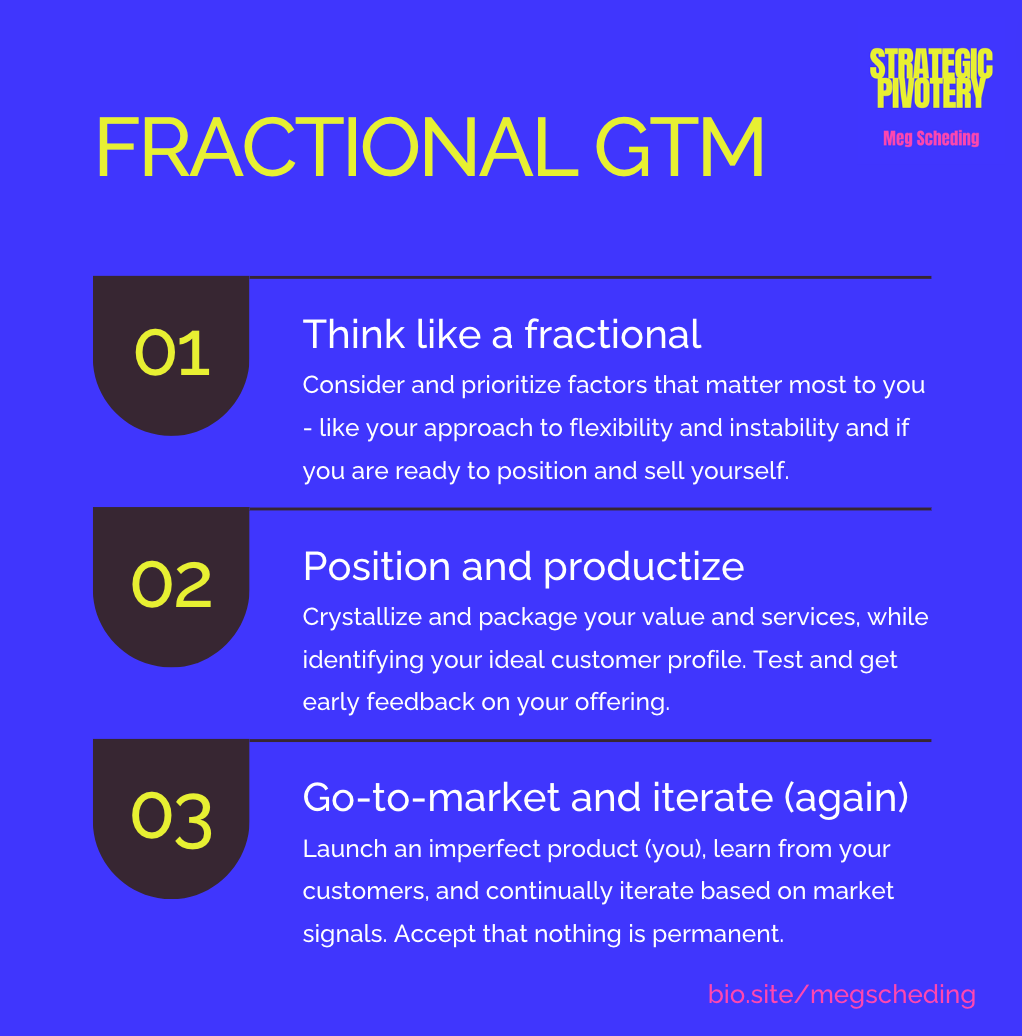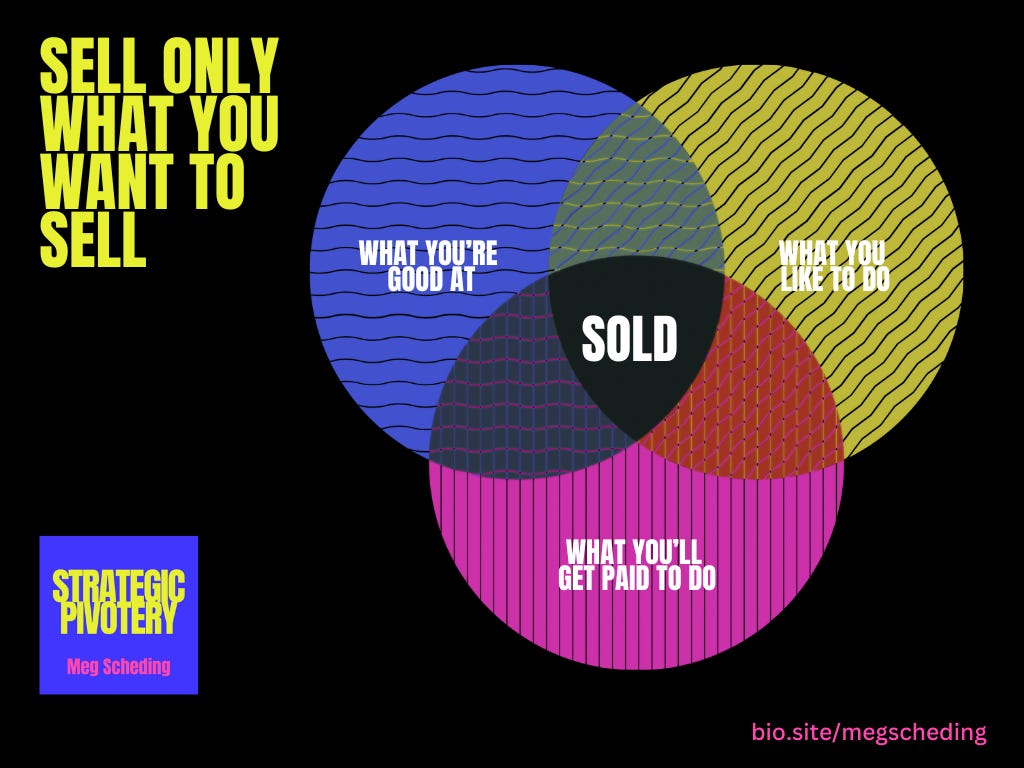How to productize yourself (part 1 of 2)
Defining your unique value and ideal customer makes the scary (sometimes icky) part of going to market so much easier
Strategic Pivotery
Hi, I’m Meg. I’ve been consulting with startups as a fractional product marketing leader for many years, and started this ‘stack to help burnt-out tech workers build $$$K+ consulting practices using the same GTM frameworks that scale unicorns.
I’ve scaled GTM and foundational messaging at Brex, Ashby, Jasper, Wand (among many) and have now built a thriving solo practice. I’m not a life coach helping people find balance; I’m a former startup operator teaching other operators how to monetize their hard-won expertise. I teach folks how to use the same tools they learned surviving startup life to build premium fractional businesses.
Want to launch your own fractional consultancy, get GTM help, or monetize your toxic startup experience? Book a chat with me or disrupt the status bro in as many colors as you can buy! :)
All the Ps
Friends, this post has been an (awesome) beast to write!
That’s because Step 2 of my approaching fractional work as a GTM exercise series spans all the Ps - productizing, positioning, pricing, packaging, and (ideal customer) profiling.
It’s so foundational that I’m breaking this into 2 sub-posts. The first post is below, and the second is now live here.
This post will cover:
An overall framework for productizing yourself
How to determine what you should sell
Identifying and understanding your ICP
The framework above is from post 1 on how to approach fractional work as a go-to-market exercise. I recommend reading it before diving into this post.
Many folks are interested in fractional work, but they face a big internal hurdle: selling themselves. Nailing all your Ps helps you realize that selling yourself will never be icky if you’re offering valued services to people who are likely to buy them. More on that here.
But how do you get there? Apologies in advance, but my “how to” guide is not as linear as it seems. I tackled all the Ps at the same time, iteratively, and on-demand. I didn’t create a pitch deck until a prospect asked if I had one (“I do now!”). I didn’t have a blurb until a superconnector friend said “What can I forward along to my contact to explain what you do?”
You also don’t do these activities once and boom, you’re done forever. Imagine building software and then never adding to the roadmap! I continue to test, get feedback, and improve my go-to-market constantly. I just updated my pitch deck last week based on an “aha” moment I had with a trusted former colleague.
You are the product
I cannot write or say this enough: if you want to be a fractional or consultant, your mindset needs to change on how you view yourself. Step 1 (thinking like a fractional) is the soul searching you may not want to do, and Step 2 is applying the same self-editing and self-promotion you already employ when you’re taking a company’s product or service to market.
Have you loved or believed in every product a company has asked you to support or sell? Meh, but you still took that product to market (regardless of what department you were in). You probably hyped the s-hit out of it, too.
As a fractional, you now can sell something you believe in - yourself! Thinking of yourself as the product will hopefully remove some of the inherent self-doubt and imposter syndrome that can occur when you work for yourself (still happens to me, btw).
(Also, look at that last sentence and linger over the phrase “work for yourself” -- isn’t that such a tasty thought?!)
If you’re reading this post, then you think what you have to offer is attractive to the market. Unfortunately, there’s no comprehensive Tinder-style matching app for companies and fractionals (yet). That’s why the Ps are so important:
Let’s walk through the main activities (and best practices) to productize yourself. Putting in the above work will improve your hit rate with potential clients.
What’s on offer?
Activity: Assess your skills and expertise
Outputs: What do you like to do, and what can you get paid to do? (your offering)
When I coach people on becoming fractional, the first step is discovery — about themselves. I ask them to create three lists:
What you’re good at doing
What you think you’ll get paid to do (aka, the market wants this)
(and the sleeper VIP) What you like to do
As you approach the last one, your list should get very targeted (read: small).
What you’re good at doing
Did you “wear a lot of hats” at your full-time job? Of course you did. Will you wear all of them while consulting? Nope. You’ll be hired to employ a fraction of your entire skillset, which can seem scary.
Do you need to tell your prospective clients about every skill you have? Definitely not.
But Meg, I’m good at so many things! I hear you, but humans zone out when you give them too many options. And if you have 15 key skills, do you really want to go to market with the 15th one? Is it as valuable as your top skill?
Instead, be ruthless:
What you can get paid to do
If you don’t have a good idea of which of your skills is most marketable, ask your network for feedback. Ask your colleagues what they think your superpower is, or how they’d pitch you to their boss or startup friend. This may surprise you, but getting an idea of what the market may pay for is key.
Then start narrowing your go-to-market offerings (it should be 10 or less). You can always broaden your services if you perceive demand in another area; for now, focus on the “land and expand” approach like the very best enterprise SaaS account executives.
What you like to do
This list should be the smallest number. Not only is this necessary to sustain your prospects’ attention, but you’ve just started the conversation by being in control of what you will and won’t do. As you actively work on projects, you can gradually say yes to areas that weren’t in your original scope but more importantly, you can say NO.
Bonus: you probably don’t enjoy employing skills #10-15 anyway. You never have to offer them again, unless the market can bear you pricing them exponentially high.
Who’s likely to buy?
Activity: Identify, prioritize, and target ICPs
Outputs: Ideal customer profiling
Understanding the pain points and needs of your ideal customer profile (ICP) is the key to unlocking true growth as a fractional.
When I first went to market as a consultant, I positioned myself as a product marketing generalist, because I thought staying broad would allow me to capture the most interest. But over the past 7 years as a fractional, I’ve carved out a very specific ICP based on what has landed:
Company profile:
B2B SaaS companies (I no longer advertise myself as a D2C PMM, even though I could flex to do that)
Series ~Aish (it’s usually when they realize they need a senior-level PMM to set strategy)
Often moving upmarket and hitting a cliff with first-gen GTM motion and messaging
Verticals I already have experience in like fintech, HR tech, martech, ed tech, fem tech, research marketplaces; clients skeptical of hiring consultants feel more secure when you have industry-specific expertise
Buyer profile:
Head of Marketing / CMO
Head of PMM
Relatively new-ish to the position
Hasn’t built out a team / has urgent gaps needing to be filled (parental leave coverage, expansion into a new market, needs to upskill inherited team members)
Secondary ICP: founder / executive team recognizes they need to refresh their messaging
You (hopefully) have opinions on your first ICP. Follow your instincts, but here were 2 areas that surprised me:
The type of companies who hire me full-time aren’t always the same types that hire me as a fractional
My ICP changed from Series B+ to Series ~Aish
That’s because a company hiring a full-time Director or Lead PMM is experiencing different problems than a company looking for fractional PMM / GTM support. If you think your ICP may be at a different stage than what you’ve typically worked for, look for examples in your network that can give you insight into their problems and how they perceive the costs and benefits of hiring fractionals. There are some companies, regardless of stage or industry, that will never entertain consultants and they are never your ICP.
You know who is also never your ICP? Assholes. Now that you are going to market with a product you love (you!), opt not to to work with them. You may not always be able to gauge this from a few meetings, but trust your gut and don’t ignore red flags. If you really need the cash, give the project a clear expiration date (“I only have capacity for 10 hours a week” or “let’s do a month trial period”) and ensure your contract supports you being able to leave the project without damages.
Next post will cover the back half of the Ps —> and it’s now live!
Positioning
Marketing
Pricing (oh, yah$$$)
Using market signals to iterate and grow
Ways you can value and support Strategic Pivotery (Meg)
🙊 Book a strategy (or vent) session
Want to discuss how to launch or expand your consultancy? Need help getting unstuck and back on the right track? Pay to pick my brain / book a strategy session with me. Share an agenda, and we problem-solve for the most helpful and actionable next steps per minute.
☕️ Buy me a chai latte
Not ready for a virtual coffee chat but still want to support me? Strategic Pivotery is free (and I’d like to keep it that way, at least for now!). If you find it helpful, it made you smile, or I got a belly laugh — buy me a coffee (well, chai latte - I don’t drink coffee). I prefer monetary validation to another mediocre white dude telling me “you’re actually really good at this.” Thanks, bro!
I love the ❤️ too - like, comment, share, restack this post so it gets discovered by the dark internet.
🧢 Disrupt the status bro (but make it fashion)
My online friends said “put that on a t shirt,” but I started with hats.
☎️ Tell me!
Where do you need the most help?
Assess your skills and expertise
Identify, prioritize, and target ICPs
Getting market signals / getting in front of folks






